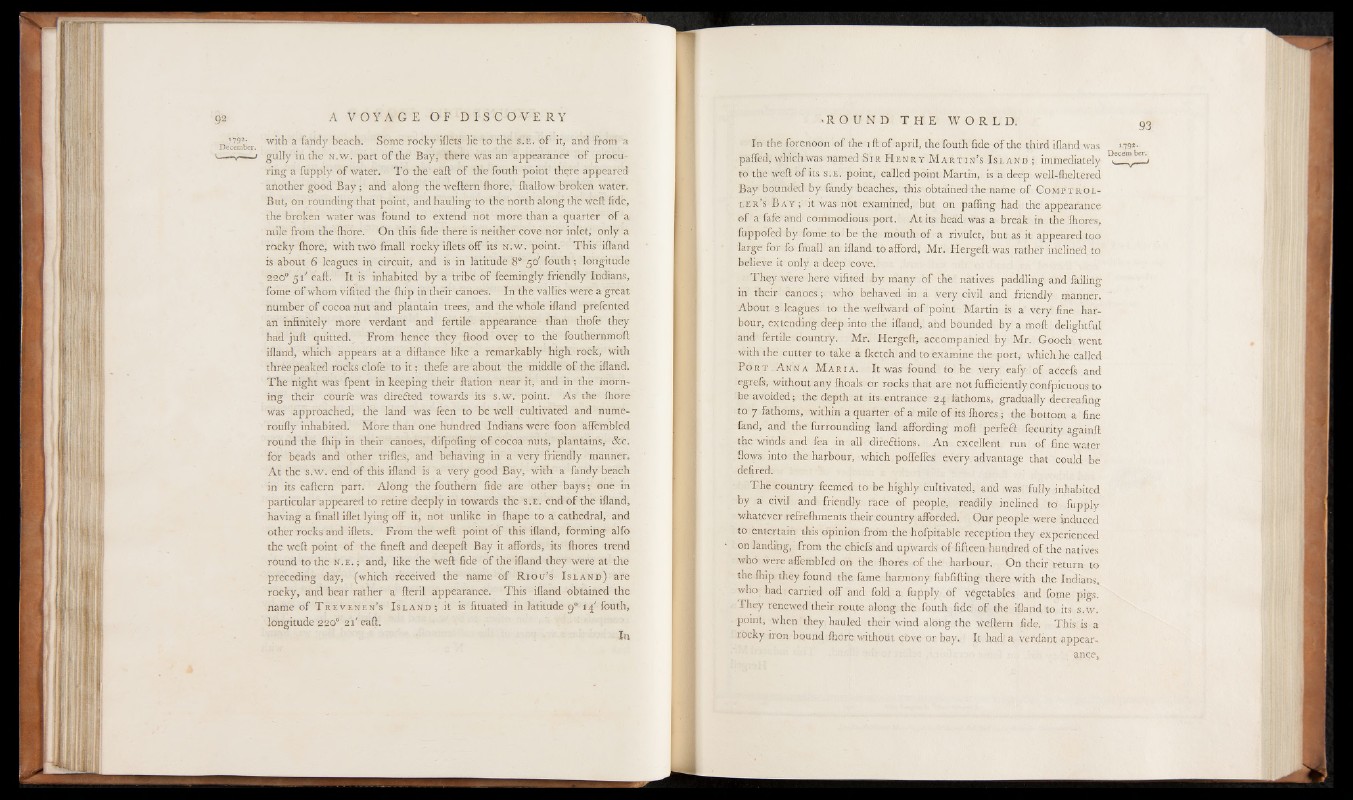
1 1
I
Li
92 A V O Y A G E O F D I S C O V E R Y
1792. wltli a fandy beach. Some rocky iflets lie to the S.È. of it, and from a
December. t J ^ , ( r ,, , ..
c.— ----> gully in the N.w. part of the Bay, there was an appearance ó f procuring
a fupply of water. T o the eaft of the fouth point there appeared
another good B a y ; and along the weftern fhore, (hallow broken water.
But, on rounding that point, and hauling to the north along the weft fide,
the broken water was found to extend not more than a quarter of a
mile from the lhore. On this fide there is neither cove nor inlet; only a
rocky fhore, with two fmall rocky iflets off its N.w. point. This ifiand
is about 6 leagues in circuit, and is in latitude 8" 50' fouth; longitude
220° 51' eaft. It is inhabited by a tribe of feemingly friendly Indians,
fome o f whom vifited the {hip in their canoes. In the vallies were a great
number o f cocoa nut and plantain trees, and the whole ifiand prefented
an infinitely more verdant and fertile appearance than thofe they
had juft quitted. From hence they flood over to the fouthernmoft
ifiand, which appears at a diftance like a remarkably high! rock, with
three peaked rocks clofe to it; thefe are about the middle of the ifiand.
The night was fpent in keeping their ftation near it, and in the morning
their c’ourfe was direfled towards its s.w. point. As the fhore
was approached; the land was feen to be well cultivated and nume-
roufly inhabited. More than one hundred Indians were foon aflembled
round the fhip in their canoes, difpofing o f cocoa nuts, plantains, &c.
for beads and other trifles, and behaving in a very friendly - manner.
A t the s.w. end of this ifiand is a very good Bay, with a fandy beach
in its eaftern part. Along the fouthern fide are other bays; one in
particular appeared to retire deeply in towards the s .E . end of the ifiand,
having a fmall iflet lying off it, not unlike in fhape to a cathedral, and
other rocks and iflets. From the weft point of this ifiand, forming alfo
the weft point of the fineft and deepeft Bay it affords, its Chores trend
round to the n .e . ; and, like the weft fide of the ifiand they were at the
preceding day, (which received the name of R io u ’s I s l a n d ) are
rocky, and bear rather a fteril appearance. This ifiand obtained the
name o f T r Ev e n e n ’s I s l an d ; it is fituated in latitude 9° 14' fouth,
longitude 220° 21' eaft.
In
« R O U N D T H E W O R L D . 93
In the forenoon of the lft of april, the fouth fide o f the third ifiand was > 792.
paffed, whichwas named S ir H e n r y M a r t i n ’s I s l a n d ; immediately -
to the weft o f its s.E. point, called point Martin, is a deep well-fheltered
Bay bounded by fandy beaches, this obtained the name o f C o m p t r o l l
e r ’s B a y ; it was not examinëd, but on palling had the .appearance
of a. fafe’ and commodious-port. A t its head was a break in the fhores,
fuppofed by fome to : be the mouth of a rivulet, but as it appeared too
large for fo fmall an ifiand tó afford, Mr. Hergeft was rather inclined to
believe it only a deep cove.
They were here vifited ,by many of the natives paddling and failing
in their canoes; who behaved in a very civil and friendly manner. "
About 2 leagues to the weftward of point Martin is a very fine harbour,
extending deep into the ifiand,! and bounded by a mod delightful
and fertile country. Mr. Hergeft, accompanied by Mr. Gooch went
with the cutter to take a flcetch and to examine the port, which he called
P o r t . A nn a M a r i a .- It was found to be very eafy of accefs and
egrefs, without any fhoals or rocks that are not fufficiently confpicuous to
be avoided; the depth at its entrance 24 fathoms, gradually decreafing
to 7 fathoms, within a quarter of a mile of its fhores!; thé bottom a fine
fand, and the furrounding land affording moll pérfeö: fecunty againft
the winds and fea in all direflions. An excellent run of fine water
flows into the harbour, which poffeffes every, advantage that could be
defired.
The country feemed to be highly cultivated, and was fully inhabited
by a civil and friendly race of people, readily inclined to fupply
whatever refrefhments their country afforded. Our people were induced
to entertain this opinion from the hofpitable reception they experienced
on landing, from the chiefs and upwards o f fifteen hundred of the natives
who were aflembled on the fhores of the harbour. On their return to
the fhip they found the fame harmony fubfifting there with the Indians,
who had carried off and fold a fupply-.Of vegetables and fome pigs.
They renewed their route along the fouth fide o f thé ifiand to its s.w.
point, when they hauled their wind along the weftern fide. This is a
rocky iron bound fhorè without cove or bay. It had a verdant appearance,